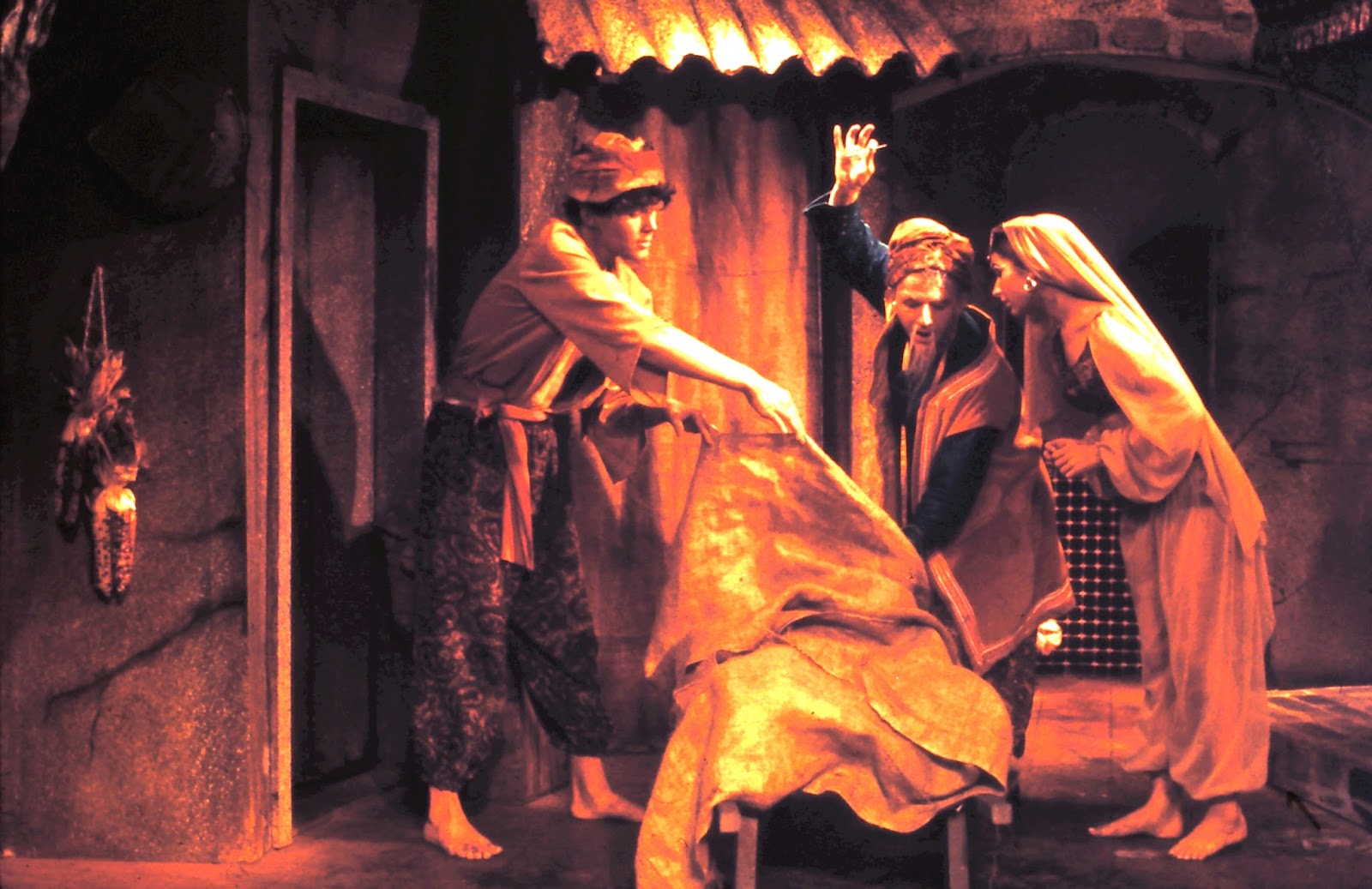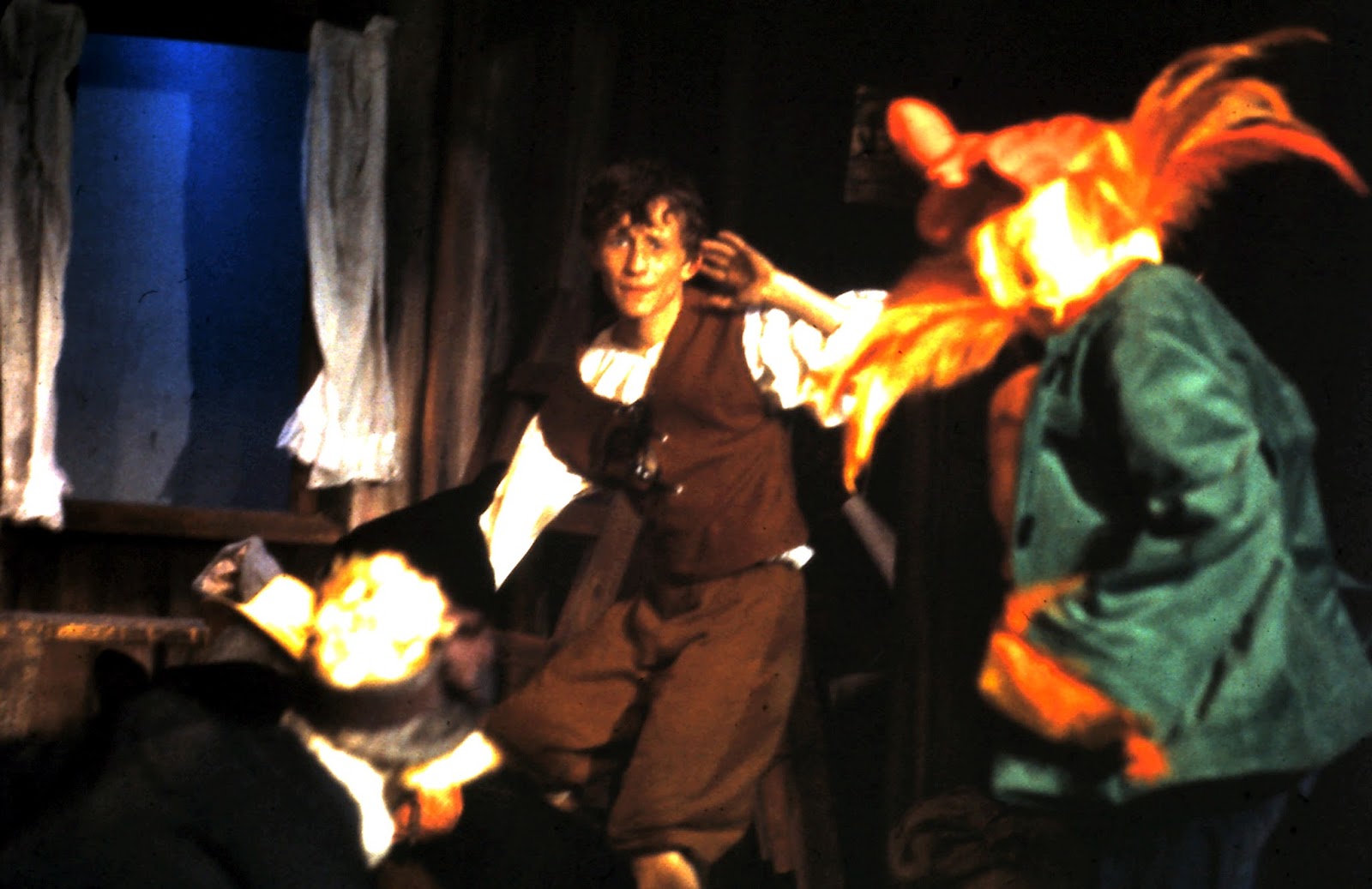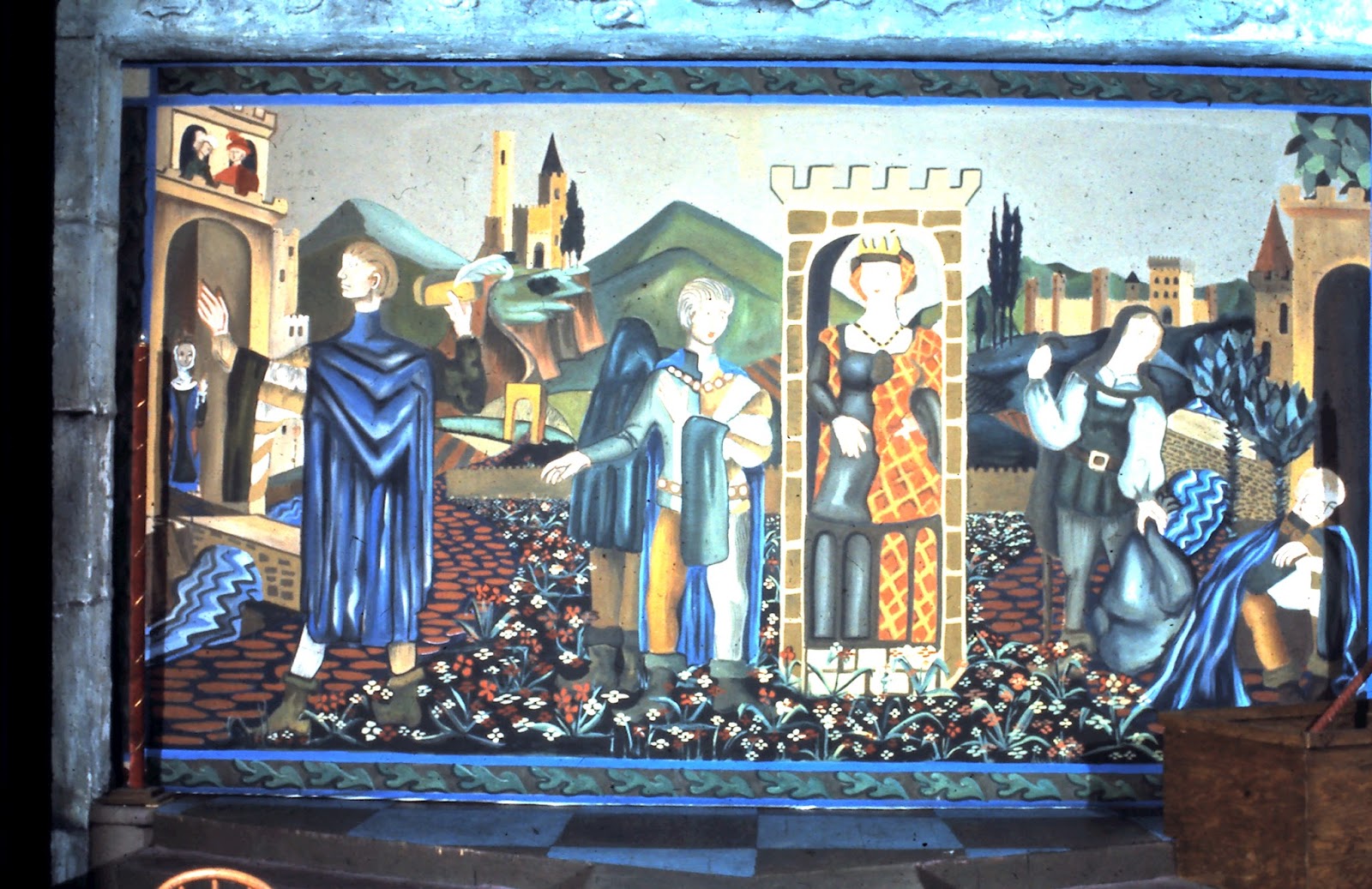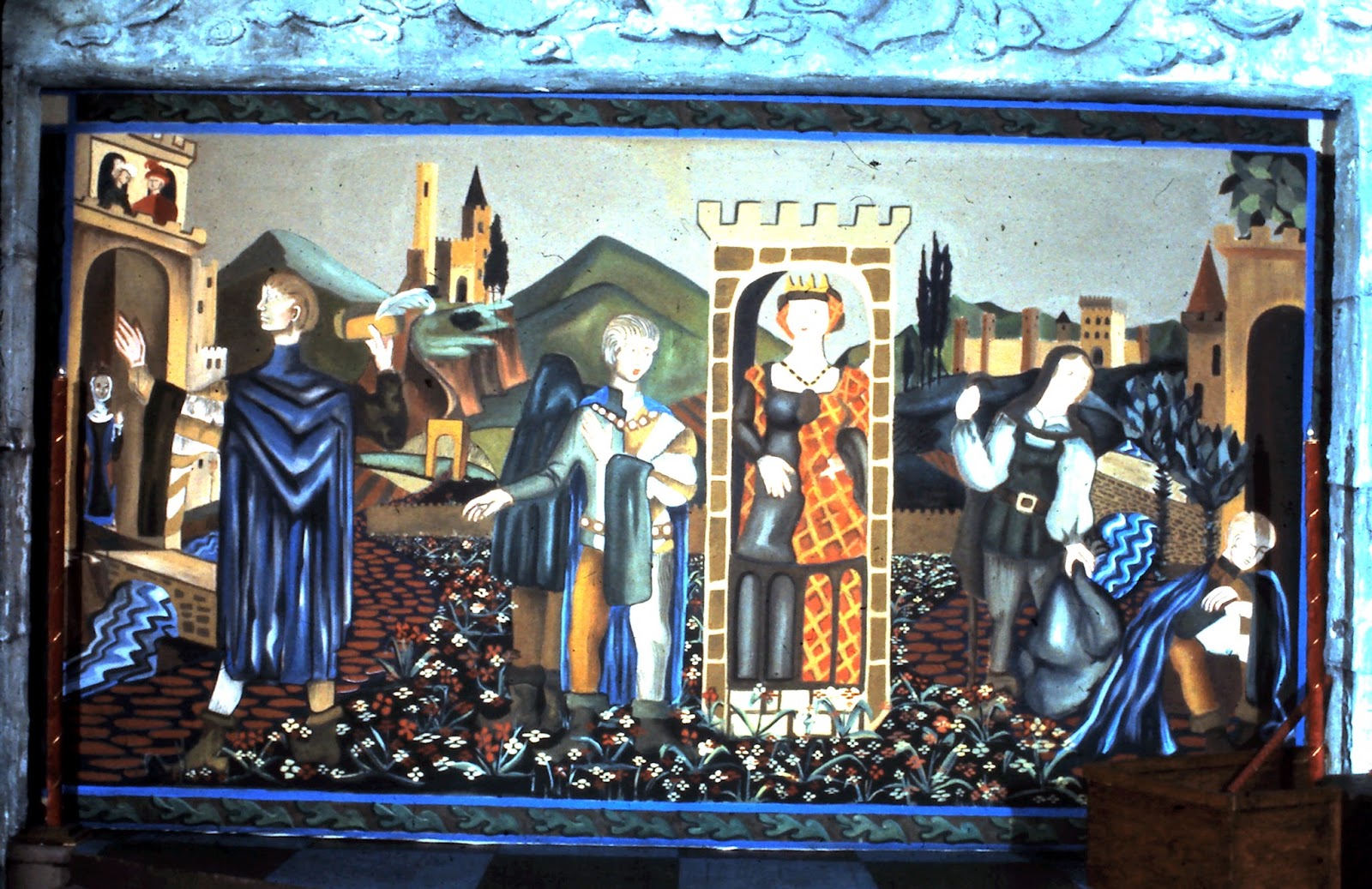1961-65
 |
| Mr. Muffy's Magic Mimes. 1965. |
Excerpt from the preface to Five Plays from the Children's Theatre Company of Minneapolis, written by Linda Walsh Jenkins:
The concept that ultimately became the Children's Theatre Company began to evolve in 1962, when John Clark Donahue, a young painter, actor, and art teacher, started to work with the Moppet Players of Minneapolis, a children's theater group led by Beth Linnerson. When Donahue joined the small company, it was only a year old. The Moppet Players were adult and child volunteers who combined their skills in creative dramatics and improvisation to develop children's plays in which both adults and children participated as actors. At first they performed in a back room donated by Mama Rosa's, a restaurant in the West Bank community near the University of Minnesota. Then they moved into a building that had once housed a police station, and they obtained shop facilities in the neighborhood. Donahue was soon writing and directing for the Moppet Players as well as serving as their technical director and designer; he became artistic director of the company in 1964.
During these years Donahue's dual orientation toward painting and the theater found a challenging outlet in the possibilities of theater for children, and he began to formulate his dream of a new theater company that could create works on a much larger scale than that available to the Moppets. Ideological conflicts led to a split in the company, and Donahue and John Davidson, the managing director of the Moppets, went in search of a new artistic home. They found one at the Minneapolis Institute of Arts, and in 1965 the Children's Theatre Company opened its first season of plays there.
1961-1962
1962-1963
1963-1964
1964-1965
1963
Tyll's Merry Pranks
Ozma of OZ
Hansel and Gretel
1964-65:
The World of Mother Goose
The Princess and The Pea
The Act Curtain, designed and painted by John Clark Donahue
Mr. Muffy's Magic Mimes
Jack and the Beanstalk
The Moppet Players reunite for a 50-year reunion
By Elyse KanerStaff Writer
The Moppets, a once popular children’s theater originally based in Minneapolis, was recently back in action. If only for a day.

Former Moppet Players Marlene Braun (left to right), founder and director Beth Linnerson-Daly, Myron Johnson and Helen Rannow recently reunited for a 50-year reunion of the once popular Moppet Players Children’s Theatre. Photo by Missy Hilger
The group in August celebrated a 50-year reunion with flare, make that sparklers, and with a multitude of candles blazing atop a bundt cake to spice up the drama of the much anticipated get-together.
“It was so emotional for everyone,” said Coon Rapids resident Helen (Mithun) Rannow.
Rannow, 59, along with her sister Marlene Braun, 62, also of Coon Rapids, and their brother Ervin Mithun, 64, of Lebanon, Ore., and cousin Rick Stoneburg, 57, of Blaine were a few of the kids in the West Bank neighborhood back in the 1960s who joined the theater group of children looking for something to do after school and on weekends. It took them into a journey of fantasy and fun.
Too shy to act, Rannow and Braun, worked as stage crew members. They painted scenery and manned the concessions, selling orange drinks and candy during intermission, and they helped with clean up. They collected tickets at the door. Cost for theater admission at the time was 25 cents.
As part of cleanup duty, Rannow vaguely recalls as a 10-year-old strapping scrub brushes to the bottom of her feet and skating across the floor of an old renovated police station that once housed the Moppet theater.
“It was really all about the children,” Rannow said about the group.
Said Braun, “It was our playground of imagination. We actually had the means and the costumes and the people around to spark our imaginations.”
The founders
Beth Linnerson-Daly, with the technical support from her brother John Linnerson, founded and directed The Moppet Players Children’s Theatre in 1961. The spunky theater student at the University of Minnesota in the ‘60s was waitressing at Mama Rosa’s restaurant in Minneapolis. When the owner informed her a back room was available to stage plays, Linnerson-Daly soon set into action what would become a popular theater company for children to delve into acting and creating scenery, to foster hope and friendships, and to create a safe haven, an escape for kids from what was otherwise known as a poor Minneapolis neighborhood at the time.
“She was our Mary Tyler Moore,” Rannow said.
Linnerson-Daly, 76, now a resident of Trenton, N.J., was at the party this summer, center stage, star of the show, with a cast of 35 reunion members and some of their family members. In a shining theatrical moment, Linnerson-Daly emerged from the kitchen of a darkened Minneapolis home where the reunion was held with sparklers in hand.
Cut to a lot of hugging. Reminiscing. A porch doubling as a screening room where Moppet photos taken so long ago flipped across a TV screen.
The Moppet family once again was one., for those who could make it. Some still live in the area. Some live out of town. Some had passed on. Others phoned in to say “hi.”
“It was a truly extraordinary experience seeing folks I had worked so closely with and not seen since the ‘60s,” Linnerson-Daly said. “(It was) very touching to know we had made children’s lives a little more interesting and exciting.”
The reunion was held in the home of former Moppet Sandra Nei Schulte. Since immersing herself into The Moppets as an actor, director and more, Nei Schulte has worked as head costumer for the Chanhassen Dinner Theatre and is now costumer for the Augsburg College theater department.
They moved three times
After a two-year stint at Mama Rosa’s restaurant (1961-1962) on Cedar Avenue and three years (1962-1965) at the renovated police station at 1826 S. Fourth St., under the auspices of The Pillsbury Citizens Service and Waite Neighborhood House, The Moppets moved from Minneapolis to St. Paul’s Arts and Science Center (1965-1968).
They performed not only in theaters but at schools and art centers throughout the state. The group’s final performance in 1968 was held at Minneapolis’ Tyrone Guthrie Theatre sponsored by the Walker Art Center.
In its final year, The Moppet Players on a federal grant played 180 performances in schools.
But Linnerson-Daly decided she needed a change of pace and moved to New Jersey.
A branch of the Moppets later became the Children’s Theatre Company under the direction of John Davidson and John Donahue.
The organization grew into the prestigious Twin Cities Children’s Theatre now under the direction of Peter Brosius, according to a written statement by Linnerson-Daly.
The Moppets created community
In preparing for this summer’s reunion, Linnerson-Daly managed to track down nearly 50 people formerly connected with the Moppets.
The theater spawned such thespians as Danny Seagren, who played Spider Man on the “Electric Company,” worked as a voice for the Muppets and was an alternate for Big Bird on “Sesame Street.” Jill Larson went on to play Opal Cortlandt in the soap opera “All My Children.” Choreographer Myron Johnson, founder and artistic director of the Northeast Minneapolis-based Ballet of the Dolls at the Ritz Theater, was once a Moppet.
The idea back then was to create community and a theater experience, a place for kids to go, Rannow said.
“We felt so safe and secure around her,” she said of Linnerson-Daly. “She was an aunt figure, an older sister. She looked after us.”
The kids were rewarded for their efforts, too. That first year, Mama Rosa’s fed them free pizza. Beth often brought or made treats. Some were exotic to the kids. Pancakes with orange marmalade syrup. Fresh fruit. Something Rannow didn’t have in her home growing up.
One of Rannow’s fondest memories is when she dressed up in a costume at the old police station.
“I remember as we came down the stairs thinking we were so pretty in these gowns,” she said. When they reached the bottom, the adult volunteers (who were in their early and mid-20s) danced them around the room.
Sneaking into the theater
Rannow’s cousin Rick Stoneburg and brother Ervin Mithun still have good memories about the theater. They, too, worked the concessions and were part of the stage crew.
Stoneburg recalls sneaking into the theater after hours at the old police station to watch rehearsals from the back of the auditorium.
“It was like stepping into another world I didn’t know existed,” he said. “It just fascinated the heck out of me as a small kid.”
So intrigued was Stoneburg that he once sneaked down an old coal chute to watch a rehearsal.
“I had a heck of a time explaining to my mother why my clothes were so black,” he said.
The theater was a godsend to Mithun. When he was 10-years-old, he was hit and dragged by a car driven by a drunk driver. Mithun spent three-and-a-half months in the hospital and six months in a body cast. For nearly a year, he had little interaction with other kids.
A positive experience for all
But when he recovered, The Moppets changed all that.
“It gave me something to really look forward to,” Mithun said. “It gave me a chance to do something I wouldn’t normally do and to stay out of trouble.”
Mithun’s shining moment on stage came when he was cast as a guard in “Merry Tyll’s Pranks.”
He bowed and curtsied to his majesty the queen, but acting wasn’t his thing. So, he, too, worked as part of the stage crew. He helped make costumes, helmets out of paper mache and swords out of wood and tinfoil.
“It gave us perspective,” Mithun said. “(We learned) if we worked hard, we’d have something to show for it. It was real positive for all of us.”
Linnerson-Daly’s résumé includes having worked with the Lincoln Center and Guggenheim Education Departments in New York City. She is now a consultant for schools in New Jersey.
John Linnerson has remained a stanch Minneapolis supporter as production manager for the Minnesota Dance Company and more recently as property manager for Arts Space, including working with the Cowles Center for Dance and the Performing Arts, according to Linnerson-Daly.
So was the 50th reunion of The Moppets Players a success?
If huge smiles, story-telling, reminiscing about their theater days and a lot of hugging is any indication, then the answer would have to be a definite yes.
“It puts The Moppets back on the map, even if it’s only in our own minds,” Linnerson-Daly said.
The Children's Theatre and the Moppet Players
Excerpt.
This page is part of a research project by Sheila Regan, made possible in part by the people of Minnesota through a grant funded by an appropriation to the Minnesota Historical Society from the Minnesota Arts and Cultural Heritage Fund. Any views, findings, opinions, conclusions or recommendations expressed in this publication are those of the authors and do not necessarily represent those of the State of Minnesota, the Minnesota Historical Society, or the Minnesota Historic Resources Advisory Committee.
This publication has been financed in part with funds provided by the State of Minnesota from the Arts and Cultural Heritage Fund through the Minnesota Historical Society
©2012 by Sheila Regan
The Moppet Players was founded by Beth Linnerson, with technical support from her brother, John Linnerson, in 1961. Linnerson had been a waitress at Mama Rosa’s restaurant in Minneapolis, and when the owner said the back room was available to do stage plays, she formed a theater company designed to give opportunities for inner city kids, according to Elyse Kaner from ABC Newspapers.
The Moppet Players performed at Mama Rosa’s restaurant on Cedar Avenue until 1962, and then moved to an abandoned police station in the West Bank, owned by the University of Minnesota, according to Roger L. Bedard and C. John Tolch in "Spotlight on the Child: Studies in the History of American Children’s Theatre." Linnerson convinced the Pillsbury-Waite Settlement House to allow Moppet to become affiliated with that organization, and they leased the building from the University of Minnesota, according to Bedard and Tolch.
In 1962, John Clark Donahue, then a high school art teacher, began working for the Moppets as a scene designer and technical director, eventually becoming its artistic director according to Frank Whiting’s Minnesota Theatre. Over the next several years, the Moppet Players increased in popularity, getting many press write-ups. During that time they also outgrew their relationship with the Pillsbury-Waite Settlement House, especially because the organization would not allow the Moppet Players to fundraise independently, and at the same time, did not provide the theater funds, according to Bedard and Tolch.
As a side note, Minnesota Dance Theatre (previously called the Contemporary Dance Playhouse) performed their first Nutcracker Fantasy at the Moppet Playhouse at its Pillsbury-Waite location, according to a timeline provided by MDT.
In 1964, conflict arose between two different visions for the group. On the one hand, Linnerson wanted to continue working with neighborhood kids, using theater as an outlet for expression. On the other, Donahue envisioned a professional theater company, where artistry was of the highest importance. Kids would still be a part of the show (as opposed to adults playing children, which was the case with theater being done at the Women’s Club), but the end goal would be excellence. In December of 1964, the board asked Linnerson to resign in exchange for a position on the board. She refused, instead incorporating the name Moppet Players herself, according to Bedard and Tolch.
In 1965, Donahue and his camp moved into the Minneapolis Institute of Arts under a new name, The Children’s Theatre, as a program of the Minneapolis Society of Fine Arts. Meanwhile, Linnerson took The Moppet Players to St. Paul, where they performed at the St. Paul Arts and Science Center (where McNally Smith and History Theatre are located today). The Moppet continued on for several more years, touring to schools and art centers around the state, according to Kaner.










































































































.JPG)

.JPG)

.JPG)

.JPG)

.JPG)

.JPG)

.JPG)

.JPG)





























































































